1
Music Through the AirWith the advent of "wireless" communication, musical entertainment underwent huge changes. People gathered in homes where there were receivers and listened to musical entertainments and even danced to music from all over the world. As radios became more affordable, a whole new world of music was enjoyed by people in their own homes. People could now enjoy a wide variety of music, instead of being restricted by the few songs they could afford in the form of music boxes, cylinders, discs or other recorded media.
The advent of television, while at first enjoyed only in a few select locations, further changed the public perception of music. Eventually television delivered the sights and sounds of popular music into almost every home.
2
Radio, Northern Electric CompanyCirca 1910
High River, Alberta, Canada
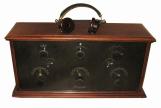 Credits:
Credits:Museum of the Highwood
3
W.W. (Bill) GrantCanadian Radio Pioneer
"Hullo, hullo, hullo. This is W. Grant of High River calling. Listen to a gramophone recording by Harry Lauder, entitled Roamin' in the Gloamin'. Hullo, hullo,hullo."
- Reported in The Calgary Herald, April 28, 1922
W.W. Grant was a radio pioneer who worked as an electrician and air force signals officer during the First World War. He worked out of a station in the High River Aerodrome. While there he established the first wireless service over the Rocky Mountains. He amazed the locals with his ability to communicate with stations all over North America. A headline in the High River Times in October, 1922 trumpeted: "San Francisco Speaks to High River via Radiophone".
In 1922, he privately built a transmitter in High River and operated it as a fully licensed radio station. He began to broadcast an hour of music in the evenings, the reception was acknowledged from as far away as Honolulu. He resigned his work in High River and moved the transmitter to Calgary where he established "The Voice of the Prairies" - CFCN radio. He also operated W.W. Grant Radio Systems Ltd. and manufactured receivers. The High River Times described the sets as user-friendly: "..with the average receiving set, tuning in can be a complicated process for the beginner. But with Mr. Grant's set it is reduced to relative simplicity and a novice should have little difficulty operating the outfit".
"The new company will proceed immediately with the manufacture in Calgary of what will be known as the W.W. Grant systems of radio telephony receiving and broadcasting sets. The sets will sell for from $10 to $200 depending on the sensitivity of the system. Today, when cities like Calgary and other major centres are all excited about the wonders of telephony, High River people have already gotten over the novelty. Many citizens here now have private receiving sets in their homes, where they listen to musical entertainments from various parts of America.
- High River Times May 11, 1922
While largely unrecognized, Mr. Grant made a tremendous contribution to the history of radio in Canada.
5
Timeline of W.W. Grant's contribution to radio in Canada1914-1935
Alberta, Canada
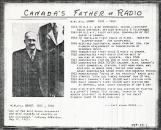 Credits:
Credits:Museum of the Highwood Archives 989-078-001
6
View of High River Airport hanger, radio tower, and other buildings.Circa 1921
High River, Alberta, Canada
 Credits:
Credits:Museum of the Highwood, 007-030-017
7
W.W. Grant's first radio station, High River Air StationCirca 1929
High River, Alberta, Canada
 Credits:
Credits:Museum of the HIghwood Archives 981-218-001
8
Radio (The Voice of the Prairie, W.W. Grant Ltd.) and speaker1910-1930
Alberta, Canada
 Credits:
Credits:Museum of the Highwood
9
Dr. Bedingfield and RadioDr. Bedingfield, local dentist and musician, was bitten early by the radio bug. He was a close associate of W.W. Grant, a southern Alberta radio pioneer. The Bedingfield's home was the first in High River to have a radio. Many social gatherings were held in the home. In 1924 he opened a radio store in High River and was the agency for the sale of W.W. Grant Radio Ltd. wireless apparatus. He also offered demonstrations and complete sets as well as parts for those wishing to build their own equipment.
The High River Times called Dr. Bedingfield "one of the most knowledgeable men in the province on the theory, science and practice of wireless".
In October 1922 the High River Times reported:
They Were Dancing to the Radio
A number of friends of Dr. and Mrs. Bedingfiled were entertained on a unique manner on Saturday evening when they danced to the strains of music supplied by W.W. Grant's radio company in Calgary. The sounds came very clearly and dancing took place in a room adjacent to the doctor's radio den.
It is remarkable the various uses the radiophone is being put to and the wonder is that more people have not intalled a set in their homes. At various intervals during evening the guests"listened in" and distinctly heard transmissions from Minneapolis and other far distant points.
10
Ad for H.E. Bedingfield's radio store21 December 1922
High River, Alberta, Canada
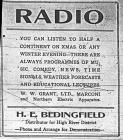 Credits:
Credits:High River Times, December 21, 1922
11
Victor radio20th Century, Circa 1930
Highwood Area, Alberta, Canada
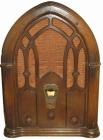 Credits:
Credits:Museum of the Highwood
12
Don King's Memoirs - RadioPost Modern, 1926-1960
High River, Alberta, Canada
Don King's Memoirs - Radio
Our family radio was originally one which used earphones. I never saw the original set, but I heard about it when I was young we still had the headphones for it. Apparently when radio was young and growing, my parents could hang the earphones on the wall and the sound was loud enough for them to hear while sitting at the table. Of course there were only the local radio transmitters in Calgary, but this was enough for a start. The next radio to enter the family was a Brunswick floor model on turned spindle legs. I don't know when it was purchased but I do remember growing up with it. I can clearly remember having to reach up to touch the knob, then seeing the knobs face to face, and then having to reach down to turn them.
That radio lasted from my earliest memory until 1946 (I was twenty), when it was retired in favour of a modern table-top model in a brown Bakelite case. The old wooden-case floor model was taken down into the basement where Dad removed the working parts, separated the top from the bottom by taking out the side and front panels, lowered the top onto the base (on top of the legs) and created a beautiful little occasional table which mother used for a telephone stand.
Credits:Museum of the Highwood, Don King's unpublished memoirs, "The Time of My Life", 2003
13
Lillian Knupp playing cards near her radio.Circa 1956
High River, Alberta, Canada
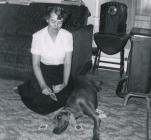 Credits:
Credits:Museum of the Highwood Archives 999-037-446
14
Radio "Idol" Talent ContestIn February 1939, an advertisment appeared in the High River Times: "Amateur Radio Contest!" Taking place at the Town Hall, the ad invited everyone over 13 to try out their talent for radio. The winners would then be featured over radio station CFAC direct from High River.
The event filled the Town Hall Opera House. People who couldn't get a seat went home to listen to the contest over their radios. Special adjudicators from Calgary were brought in to choose a winner from the 27 contestants that applied. The High River talent was impressive, with vocal solos, instrument solos, piano duets, and a brass quartet. In the end, the judges whittled the contestants down to the top eight.
First Place went to Jack Pickersgill Junior. Only 14 years old, he showed amazing skill at playing the cornet. Recieving honorable mention was the fine voice of Mrs. Tommy Logan.
A radio concert featuring the top eight contestants took place the following Monday. A brass quartet, with Jack Pickersgill Jr on cornet and his father directing, played first. Their song "Drink to me Only" was quite a hit.
